Jawetz chapters 1-2-Microbiology Review
1/110
Earn XP
Description and Tags
Provide a comprehensive review
Name | Mastery | Learn | Test | Matching | Spaced |
|---|
No study sessions yet.
111 Terms
What is the main advantage of organisms forming consortia?
A survival strategy
physiologic characteristics of different organisms contribute
The main advantage of a consortia is for survival wherein different physiological characteristics of its members contribute to the acquisition of nutrients and overcome barriers in their environment.
How do clonal communities differ biologically from single cells?
Given that clonal communities are more denser in population than single cells, clonal communities have more room for genetic variation to occur, an advantage that single cells do not have. Moreover, clonal communities have higher survival chance given that the individual cells within that community can perform tasks like obtaining nutrients and protecting one another more efficiently, making it more preferable.
A clone may contain up to ___________ or greater
10^8
Why does a high number of cells in a clone promote genetic variability?
High number of cells within a clone means that there are multiple genetic replications that occurred within these progenies, implying that different mutations could have occurred in each progeny cell of the clone.
Quorum sensing depends on the production of one or more diffusible signal molecules (eg, __________________ [AHL]) termed ____________or _____________.
acetylated homoserine lactone; autoinducers; pheromones
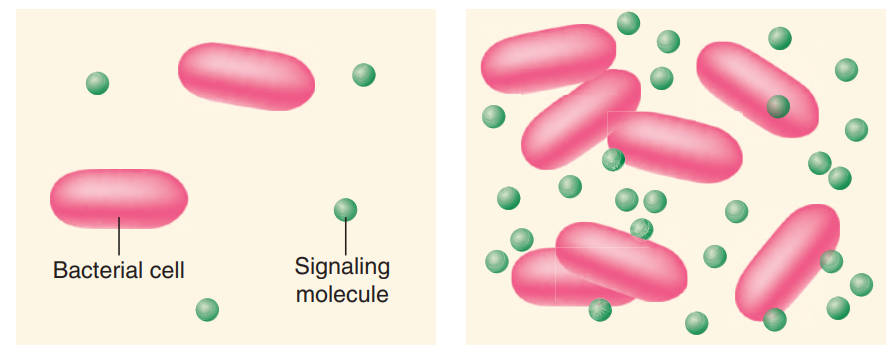
Explain this image:
When few cells are present, the concentration of the signaling molecule acylated homoserine lactone (AHL) is low.
When many cells are present, the concentration of the AHL is high. High concentrations of AHL induce expression of specific genes.
segments of DNA that interrupts informational DNA within genes
introns
In general, genetic transfer among eukaryotes depends on fusion of _____________ to form a ____________
haploid gametes; diploid cell
True or False: Possession of DNA is a useful criterion for distinguishing organisms because all cells contain DNA.
False
Given that mycoplasmas lack a cell wall, they incorporate ___________ into their cell membranes
cholesterol
Why do mycoplasmas incorporate cholesterol into their cell membranes, and how is this different from other prokaryotes?
Mycoplasmas incorporate cholesterol into their cell membranes to help maintain membrane stability and fluidity, compensating for the absence of a cell wall. This is different from other prokaryotes, which typically have rigid cell walls and do not contain cholesterol in their membranes. Mycoplasmas obtain cholesterol from their host because they cannot synthesize it themselves.
Why do chlamydiae and rickettsiae have loss of function?
smaller genome with fewer genes
How do the evolutionary trade-offs associated with symbiosis and parasitism influence the genomic and structural features of prokaryotes such as mycoplasmas, chlamydiae, and rickettsiae, and what does this suggest about their dependence on host organisms?
These adaptations illustrate that as prokaryotes evolve closer relationships with their hosts—whether symbiotic or parasitic—they often lose genes and structures necessary for independent life, increasing their dependence on the host. This shows a clear evolutionary trade-off: reduced autonomy in exchange for a more stable, resource-rich environment provided by the host.
“domesticated bacteria” that established symbiosis within the cell membrane of the ancestral eukaryotic host
endosymbionts
Now, the classification schemes for protists are based on ____________
phylogenetics or molecular methods
True or false. The flagella of prokaryotes resemble the eukaryotic flagellum
false
Red tides caused by the dinoflagellate _________ species are serious because this organism produces potent neurotoxins such as _________and __________, which accumulate in shellfish (eg, clams, mussels, scallops, and oysters) that feed on this organism.
Gonyaulax; saxitoxin; gonyautoxins
Give examples of parasitic algal genus
Prototheca and Helicosporidium
___________is a disease of dogs, cats, cattle, and rarely humans caused by a type of algae, Prototheca, that lacks chlorophyll
Protothecosis
Give two common species of Prototheca
P. wickerhamii and P. zopfii
most human cases, which are associated with a defective immune system, are caused by __________ (species of Prototheca)
P. wickerhamii
CHAPTER 2
CHAPTER 2
What is the main difference between ion-coupled transport and ABC transport in terms of energy usage?
Ion-coupled transport uses the energy from an ion gradient (like proton or sodium motive force), while ABC transport uses energy directly from ATP hydrolysis.
How do symporters and antiporters differ in the direction and type of molecules they transport?
Symporters move two substrates in the same direction, often using an ion gradient to co-transport a molecule like glycine or galactose. Antiporters move two similarly charged compounds in opposite directions using the same carrier, like exchanging H+ for Na+
In Gram-negative and Gram-positive bacteria, where are the binding proteins located in ABC transport?
In Gram-negative bacteria, the binding proteins are in the periplasmic space. In Gram-positive bacteria, they are attached to the outer surface of the cell membrane.
Why is ion-coupled transport more common in aerobic organisms compared to anaerobic ones?
Ion-coupled transport is more common in aerobic organisms because aerobic respiration, through the electron transport chain, creates strong ion (especially proton) gradients across membranes. These gradients serve as an energy source for secondary active transport. Anaerobic organisms, which rely on fermentation or less efficient pathways, produce weaker or fewer ion gradients, making ion-coupled transport less prevalent.
5. What percentage of substrates in E. coli are transported by ion-coupled transport and ABC transport, respectively?
Approximately 40% of substrates are transported by ion-coupled transport, and another 40% by ABC transport.
True or false. All types of active transport uses ATP.
False
What is group translocation and how is it different from active transport?
Active transport: Just moves stuff in (like a delivery).
Group translocation: Moves stuff in and modifies it at the same time (like a delivery plus instant cooking).

Explain the function of the Type I secretion mechanism.
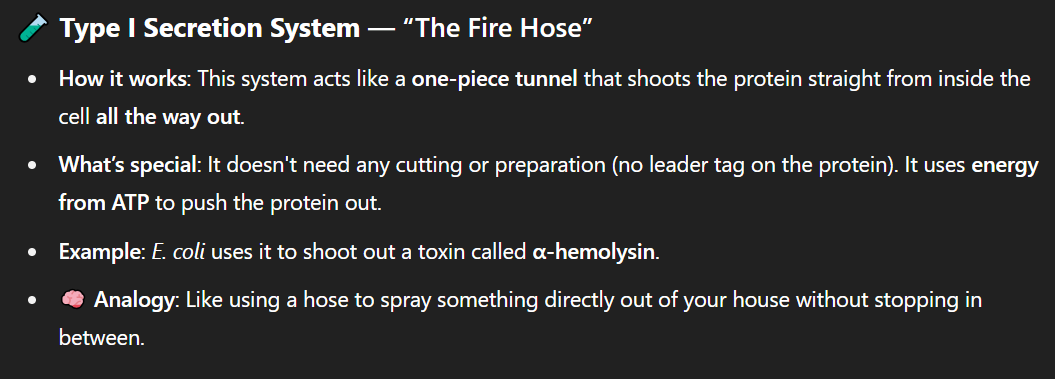
Explain the function of the Type IV secretion mechanism.

Explain the function of the Type II secretion mechanism.
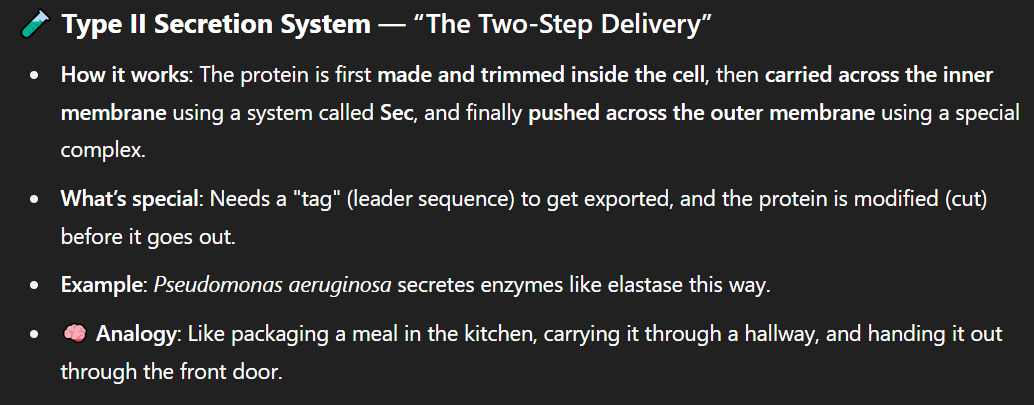
Explain the function of the Type III secretion mechanism.

Explain the function of the Type V secretion mechanism.

Explain the function of the Type VI secretion mechanism.

What are the similarities and differences between Type I and Type III secretion mechanisms?
Similarities:
Sec-independent
One-step transport
Span both membranes
Both use ATP
Differences:
Target
Structure
Contact-dependence
Signal
How are the target of Type I and Type III different from each other?
Type I targets the external environment while the Type III targets and injects into the host cell.
How are the structure of Type I and Type III different from each other?
Type I has a simple 3-part complex structure composed of the ABC transporter (IM), membrane fusion protein, and OM channel. Meanwhile, the Type III structure is complex syringe-like "injectisome" with ~20 proteins
In terms of contact-dependence, how do they differ?
Type I works without contact while Type III is contact-dependent
In what way is Type I different from Type III in terms of signalling?
Type I uses a C-terminal secretion signal, which is not present in Type III
Give examples of Type I mechanism.
α-hemolysin from E. coli; adenylyl cyclase of Bordetella pertussis
Give examples of Type III mechanism.
Yersinia Yop proteins; Salmonella SPI-1 effectors
What are the similarities and differences between Type II and Type V secretion mechanisms?
Similarities:
Gram-negative only
Sec-dependent
Two-step secretion
Differences:
Different in crossing OM
Protein state in periplasm (folded or unfolded)
Complexity
How are Type II and Type V different in terms of crossing the outer membrane?
Type II requires a dedicated multiprotein complex (T2SS machinery), while Type V transports itself using a C-terminal autotransporter domain.
How are Type II and Type V different in terms of protein state?
Folded proteins are transported in Type II, while protein must remain partially unfolded during IM transport, then folds in the periplasm in Type V
Which is more complex, Type II or Type V?
Type II
Give examples of proteins secreted by Type II mechanism.
Elastase, exotoxin A (Pseudomonas)
Give examples of proteins secreted by Type V mechanism.
IgA protease (Neisseria), VacA (Helicobacter pylori)
What are the similarities and differences between Type I and Type IV?
Similarities:
Found in both Gram-positive & Gram-negative
Span both membranes (in Gram-negative)
Sec-independent
ATP-dependent
Differences:
Function
Contact-dependent?
Structure
Secretion target
Aside from protein excretion, the type IV secretion mechanism is involved in ___________ and _____________
Conjugation; transformation
Give examples of proteins secreted through Type IV mechanism
Pertussis toxin; interleukin-8-inducing factor
Give an example of a bacteria that uses Type VI secretion mechanism.
P. aeruginosa
What is a unique element of bacterial cell wall not present in archaeal cell wall and eukaryotes?
Diaminopimelic acid
What is the function of WTA and LTA?
elasticity, porosity, tensile strength, and electrostatic properties
Most teichoic acids contain substantial amounts of _________, usually attached to position 2 or 3 of glycerol or position 3 or 4 of ribitol.
D-alanine
Techoic acids can act as ____________, which gave hint that they are located at the outside surface of the peptidoglycan.
Antigen
In the pneumococcus (Streptococcus pneumoniae), the teichoic acids bear the antigenic determinants called _____________
Forssman antigen
What are the differences between teichoic acid and teichuronic acid?
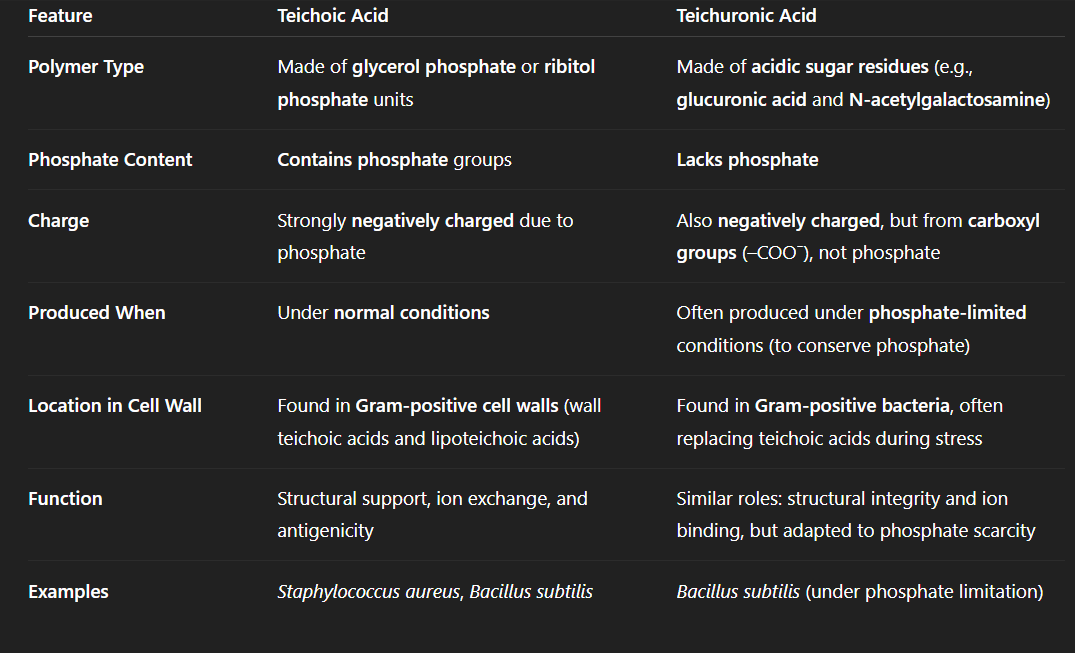
When are teichuronic acids synthesized?
when phosphate to form phosphoric acid is lacking
Give examples of neutral sugars
mannose, arabinose, rhamnose, and glucosamine
Give examples of acidic sugar
glucuronic acid and mannuronic acid
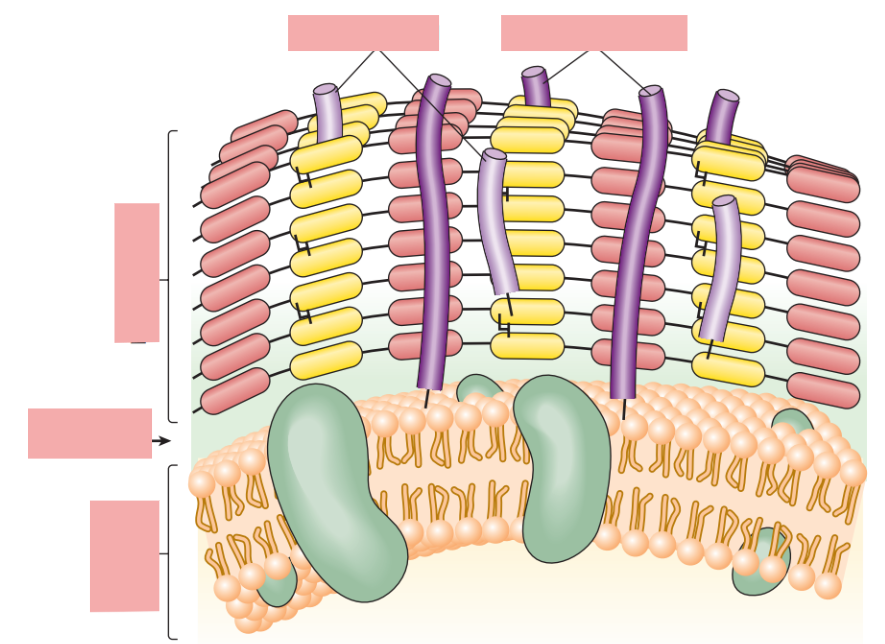
Label the structures and identify whether it is a gram-negative or gram positive
gram positive
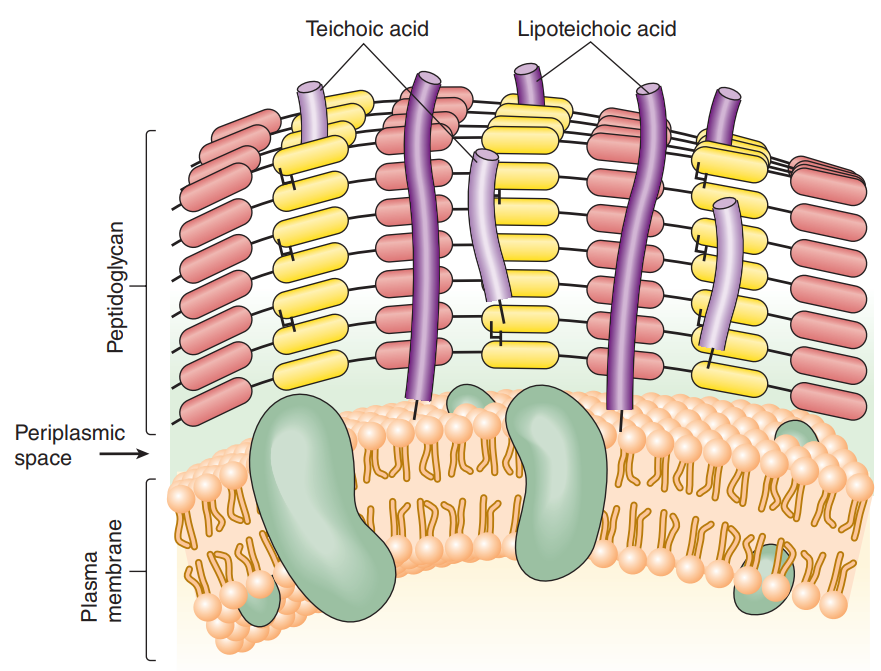
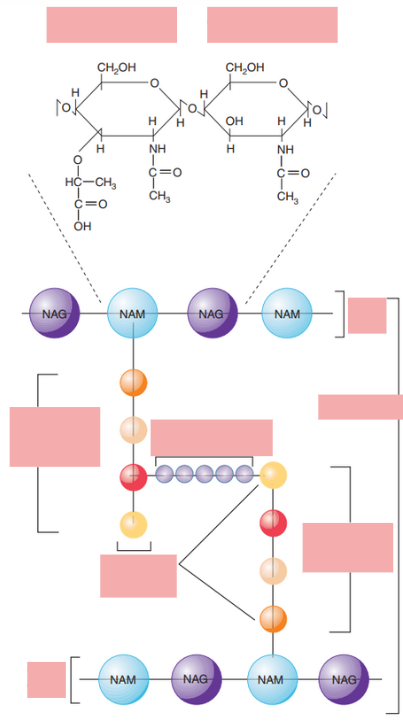
Label the structures and identify what part of the bacterial cell is shown
cell wall
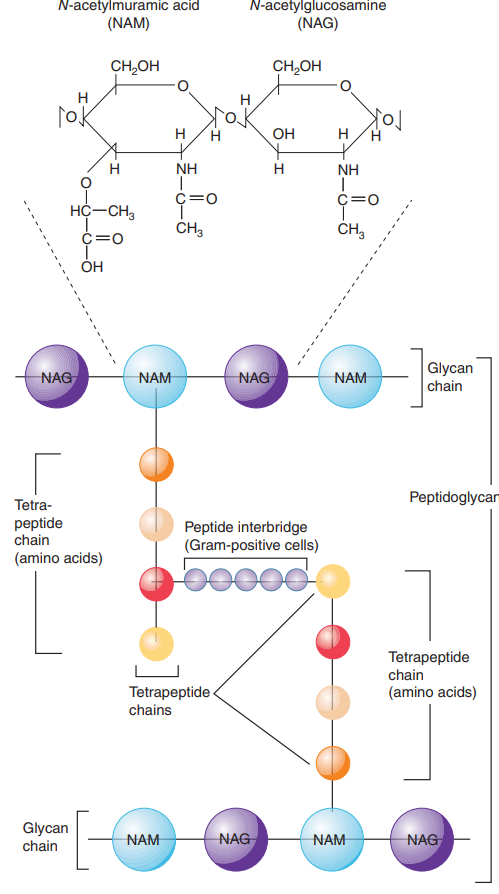
What terms are synonymous with peptidoglycan?
murein and mucopeptide
Other substituents of techoic acid may be attached to the free hydroxyl groups of glycerol and ribitol (eg, _________, _________, _______________, ______________, or ___________).
glucose; galactose; N-acetylglucosamine; N-acetylgalactosamine; succinate
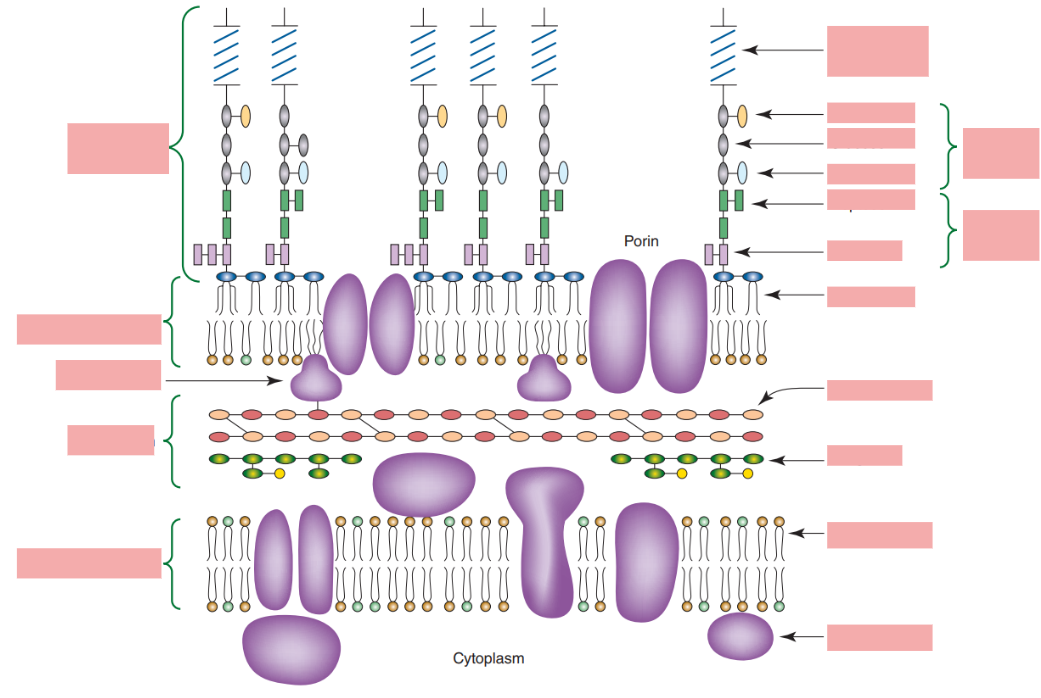
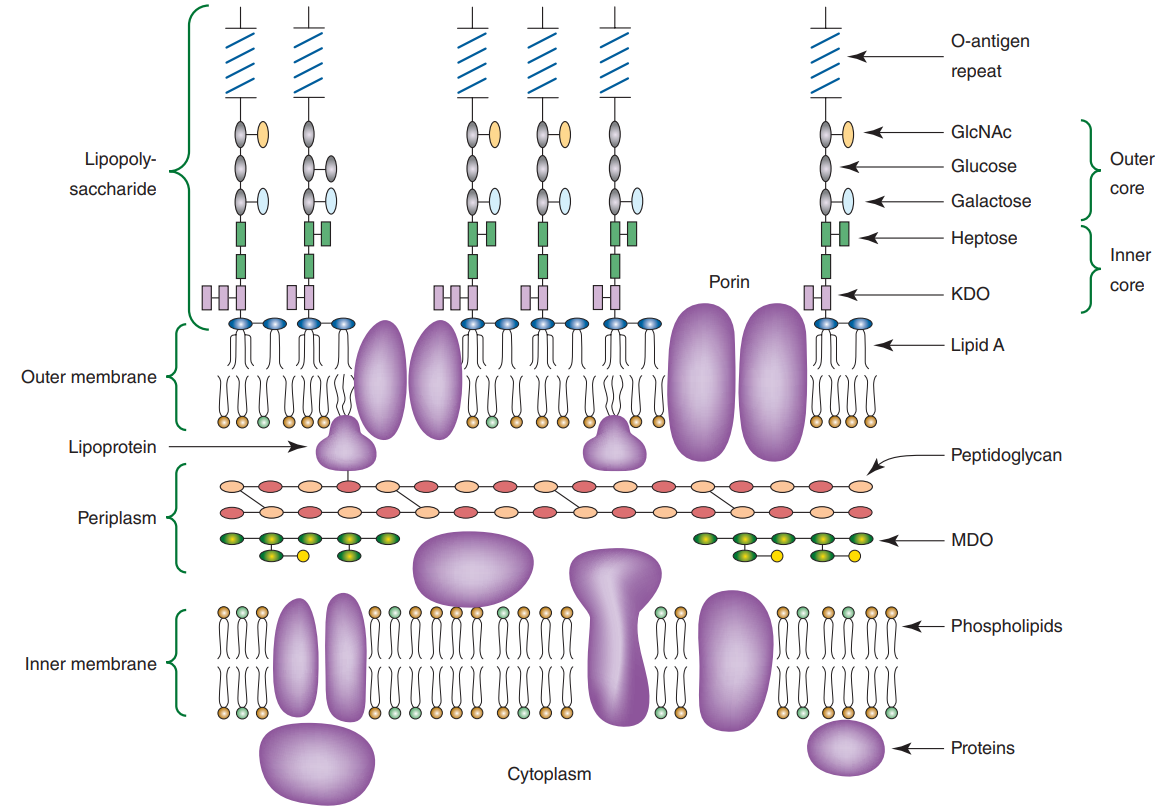

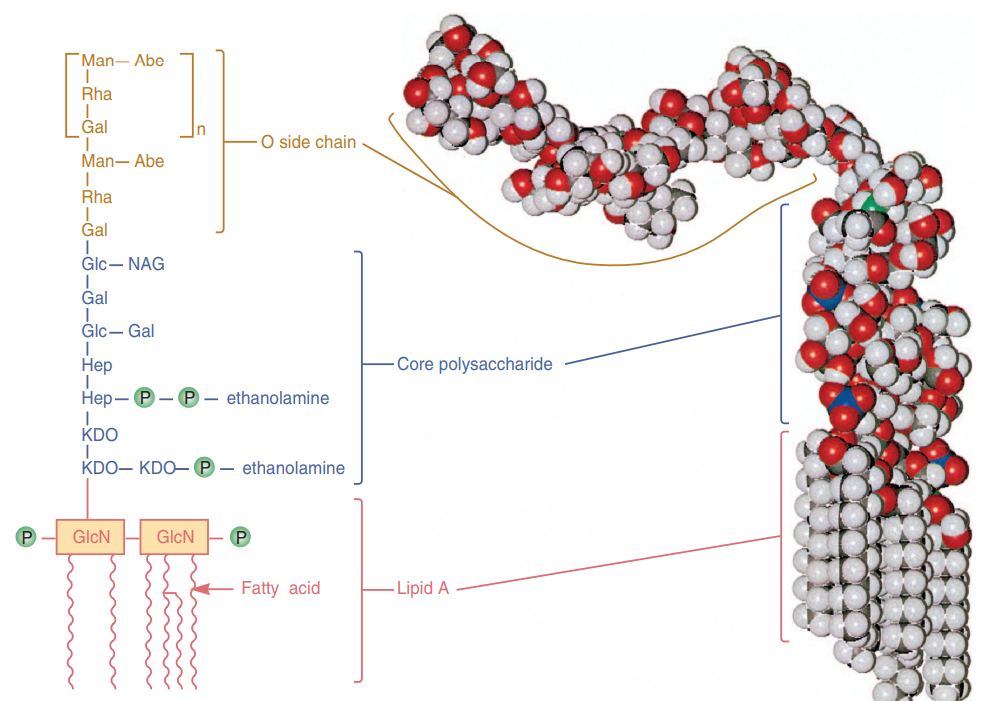
True or false. All Gram-negative bacteria have outer membrane LPS composed of a variable number of repeated oligosaccharide units
False
Describe the outer membrane of gram-negative bacteria
bilayered structure (inner and asymmetrical outer leaflet)
lipopolysaccharide (LPS) located at the outer leaflet
What special property does the outer leaflet of the outer membrane has? (In layman’s term, why is the outer leaflet weird compared to a normal cell membrane?)
to exclude hydrophobic and restricts hydrophilic materials, only letting in specific substances through porins (Omp C, D, and F; PhoE)
Give examples of porins and their functions.
1.LamB
receptor for lambda bacteriophage
transmembrane diffusion of maltose and maltodextrins
2.Tsx
receptor for T6 bacteriophage
transmembrane diffusion of nucleosides and some amino acids
3.Omp A
abundant protein
sex pilus receptor in F-mediated bacterial conjugation
Less Abundant Proteins
vitamin B12
iron-siderophore complexes
How do the different types of outer membrane proteins in bacteria help them survive and adapt to their surroundings?

What is the most abundant protein of Gram-negative bacterial cells?
lipoprotein
What are the main components of LPS?
Lipid A, core polysaccharide, and O antigen.
Which part of LPS is responsible for toxicity?
Lipid A.
Where is LPS found?
On the outer membrane of Gram-negative bacteria.
Why is LPS called an endotoxin?
Because it is attached to the bacterial surface and only released when the bacteria die or lyse.
What makes the O antigen useful for identifying bacterial strains?
It’s highly variable and unique among different species and even strains.
What does LOS stand for?
Lipooligosaccharide.
What kinds of bacteria commonly have LOS instead of full LPS?
Bacteria that colonize mucosal surfaces, like Neisseria and Haemophilus.
How does the O antigen contribute to immune evasion in Gram-negative bacteria?
By constantly varying its structure, making it difficult for the immune system to recognize and remember the bacteria.
Why might bacteria with LOS have an advantage in mimicking host cells?
Because LOS can resemble human cell surface molecules, allowing the bacteria to avoid detection by the immune system (molecular mimicry).
If a mutation prevented a bacterium from producing lipid A, how would it affect its virulence?
The bacterium would likely be less toxic and less able to cause a strong immune response, reducing its virulence.
Why might bacteria add sialic acid to their LOS molecules?
To mimic human cell markers and avoid immune system attack, especially by evading complement activation or antibody binding.
How does the structure of LOS differ functionally from LPS in terms of immune system detection?
LOS, being shorter and more host-like, is less likely to trigger a strong immune response, whereas full LPS with O antigen is more immunogenic.
What could be a consequence of removing divalent cations (Ca²⁺ or Mg²⁺) from the outer membrane of Gram-negative bacteria?
The LPS layer would become unstable, increasing membrane permeability and making the bacteria more susceptible to antibiotics.
What is the difference between mycoplasma and the L-form
Penicillin and cephalosporins are not effective in mycoplasma
L-form can revert back to their original shape given the chance, while mycoplasma does not
Why might L-forms be more difficult to eliminate with antibiotics compared to their parent bacterial forms?
evade antibiotics that target cell wall
can revert back to walled-forms
Which is more resistant to antibiotics, mycoplasma or L-form?
Mycoplasmas are usually more resistant overall due to their evolved, stable wall-less structure, while L-forms are more of a temporary survival mode that helps bacteria escape some treatments.
__________ encapsulates the cell wall of a bacteria
glycocalyx
Differentiate glycocalyx from slime layer.
Glycocalyx is defined as the polysaccharide containing material lying outside the cell. A condensed, well-defined layer closely surrounding the cell that
excludes particles, such as India ink, is referred to as a capsule.
If the glycocalyx is loosely associated with the cell and does not exclude particles, it is referred to as a slime layer.
True or false. Glycocalyx is always made of sugar like polysaccharides
False, glycocalyx can be also composed of proteins or amino acids in some bacteria.
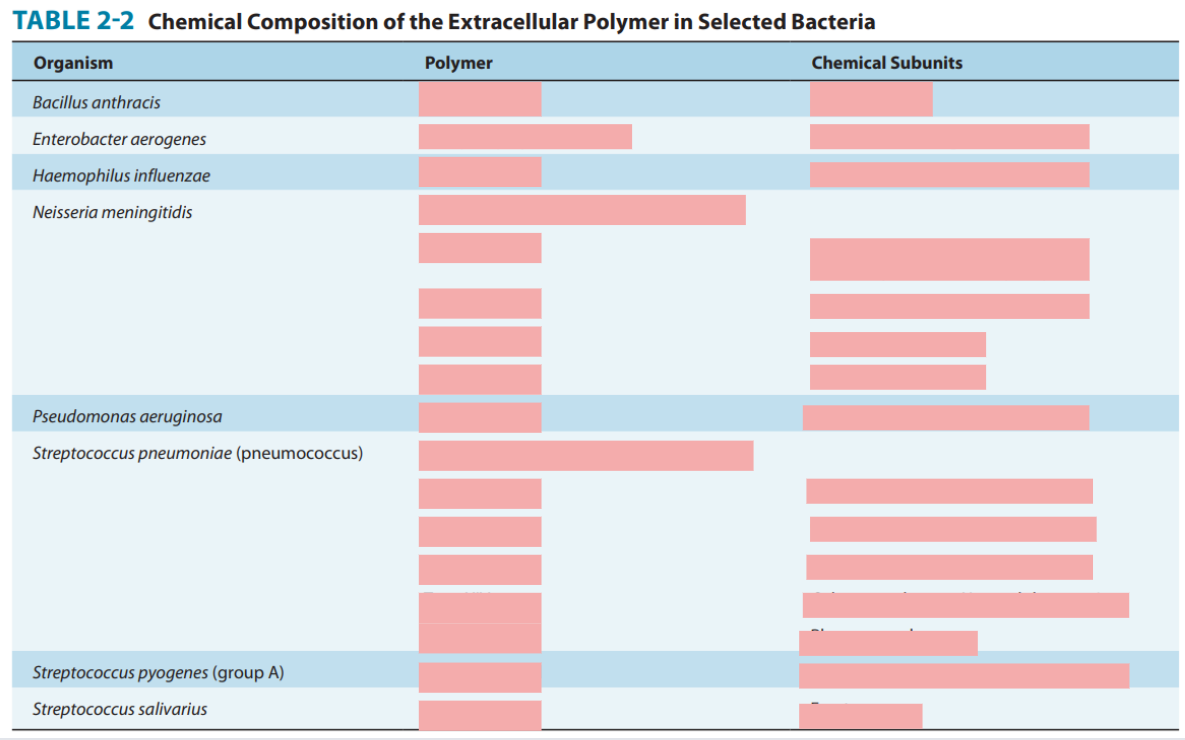
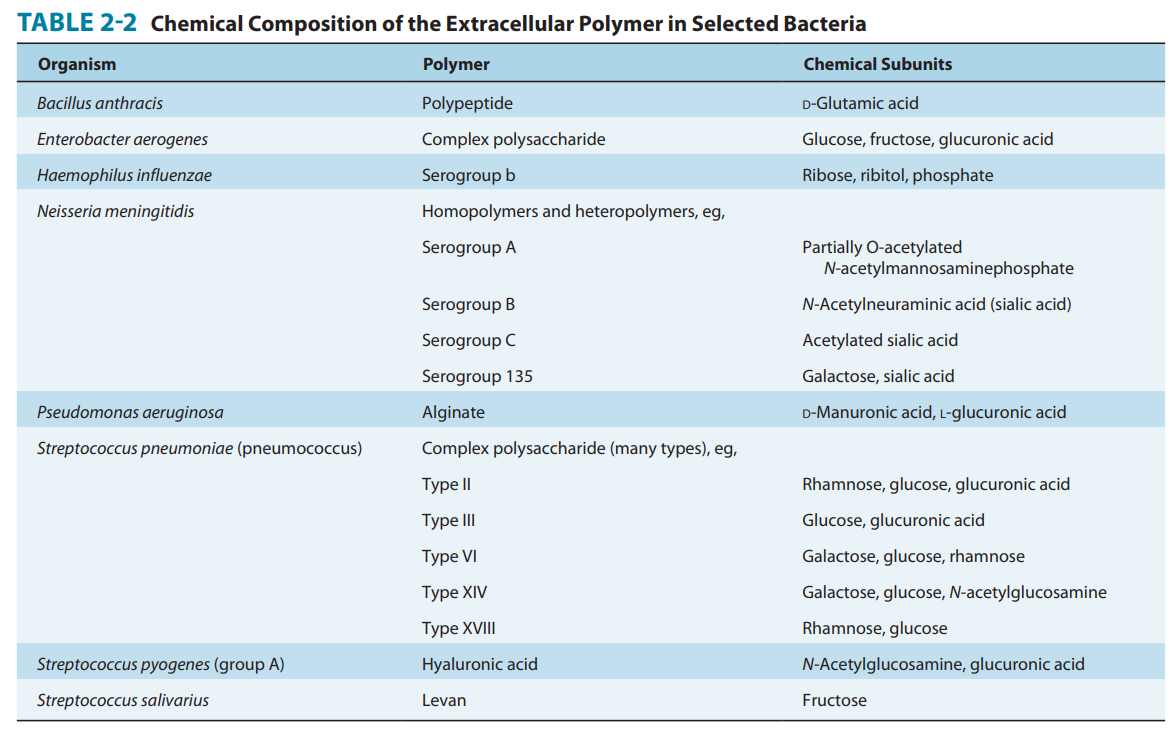
What protein subunit makes up the bacterial flagellum?
Flagellin
What are the two main structural parts of the bacterial flagellum besides the filament?
The hook and the basal body.
How many rings does the basal body have in Gram-negative bacteria?
Two pairs of rings (L, P, MS, and C rings).
What energy source drives the rotation of the bacterial flagellum?
The proton motive force (or sodium ion gradient in alkalophiles).
What behavior allows bacteria to move toward chemical attractants?
Chemotaxis.
Why might flagellin be a good target for the immune system, and how could this influence bacterial survival?
Flagellin is highly antigenic, meaning it can be easily recognized by the immune system (H antigen). This makes it a good immune target. However, because flagellins vary between species, bacteria may evade immune detection by altering flagellin structure, which aids in survival and persistence in the host.
How does the structure of the flagellum contribute to its function in motility and chemotaxis?
The flagellum’s helical filament allows it to function like a propeller. The hook acts as a universal joint, enabling flexible rotation powered by the basal motor, which uses ion gradients. Coordinated rotation leads to straight-line swimming; reversing rotation causes tumbling, allowing the bacterium to change direction and move toward favorable environments through chemotaxis.